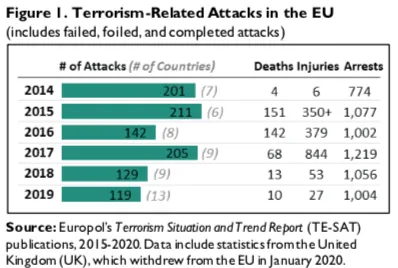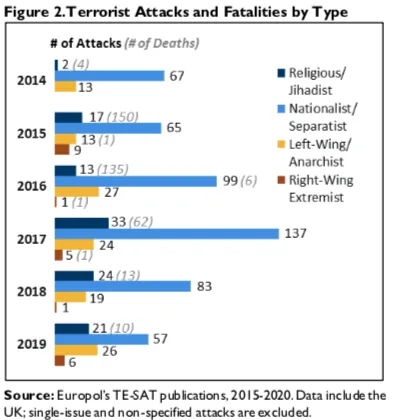Current Trends
European governments and the European Union (EU) have grappled with domestic and foreign terrorist groups for decades, but numerous attacks since 2014 have renewed concerns about terrorism and violent extremism in Europe. Despite variances in how terrorist events are defined and tracked, studies indicate that terrorism poses a security threat in many European countries (see data from Europol, the EU’s agency for police cooperation, in Figure 1).
European countries and the EU are key U.S. partners in the fight against terrorism, and Members of Congress maybe interested in European counterterrorism efforts.

Of primary concern to Europe is “violent Islamist” terrorism. Such attacks, classified by Europol as “religious” or “jihadist” in motivation, have been much more lethal than other types of terrorism, accounting for nearly all recent fatalities and casualties (see Figure2).
Most jihadist attacks in Europe since 2014 have been linked to or motivated by the Islamic State organization (IS, also known as ISIS or ISIL). Despite the group’s territorial defeat in Syria and Iraq, it maintains a low-level insurgency in both countries and continues to inspire followers in Europe. Concerns also persist about Al Qaeda and its affiliates, which remain committed to carrying out or inspiring attacks on European and other Western targets. Arrests connected to jihadist terrorism typically account for the largest number of terrorism-related arrests; 436 out of 1,004 terrorism arrests reported to Europol in 2019 were jihadist related.
Other types of terrorists also are active in Europe. Nationalist/separatist attacks consistently represent the largest proportion of all terrorist incidents. In2019, all nationalist/separatist attacks except one were related to dissident republican groups in Northern Ireland. Most left- wing/anarchist attacks occur in Italy, Greece, and Spain.
Security services warn about right-wing extremism amid what some view as heightened anti-immigrant and xenophobic sentiments throughout Europe. Some attacks by right-wing extremists may be classified as hate crimes or other offenses rather than terrorism. In 2016, a far-right, anti-immigrant extremist killed a member of the UK Parliament. In Germany in 2019, a right-wing extremist murdered a local politician in June and another killed two people in an October incident that included an attempted attack on a synagogue during Yom Kippur. In France and Germany, authorities have disrupted several far-right plots against Muslims or foreigners over the last few years.

European officials also remain alert to threats from anti-Israel groups, such as Hezbollah. No attacks in Europe have been attributed to Hezbollah since a 2012 bombing in Bulgaria, but the group reportedly uses Europe as a support and fund raising base. Some European authorities express alarm about alleged state-sponsored Iranian terrorist acts, including a thwarted 2018 bombing plot in France and two murders in the Netherlands in 2015 and 2017.
The Islamic State and Europe
Following the Islamic State’s expansion to Syria in 2013, concerns grew about the group’s ties to Europe. From2011 to 2015, roughly 5,000 European citizens traveled to Syria or Iraq to become “foreign fighters.”
Several perpetrators of the November 2015 terrorist attacks in Paris, France (which killed 130 people) and the March 2016 bombings in Brussels, Belgium (in which 32 died) were European citizens who had trained and/or fought with the Islamic State in Syria and/or Iraq. In these and other terrorist incidents in 2015 and 2016, the Islamic State may have provided remote support and guidance.
The majority of IS-linked attacks in Europe, however, have been committed by individuals inspired by IS propaganda and radicalized in small like-minded groups, online, or in European prisons. In many instances, the Islamic State claims that those responsible for attacks are its “soldiers” and some assailants use methods promoted by the group to carry out attacks (including the use of large vehicles as weapons), but there is often little to suggest a direct connection.
Despite the Islamic State’s diminished outreach capabilities amid its territorial losses since 2017, authorities remain alarmed by the group’s continued ideological influence in Europe. Some recent attacks in Europe have elevated concerns that migrants and refugees (especially youths) could be more vulnerable to Islamist radicalization and recruitment due to feeling marginalized or dislocated.
Selected Terrorism Incidents
Several incidents over the last few years highlight ongoing concerns about Islamist terrorism in Europe. The selected events below are drawn from media reports.
2018
March 23, France: A French-Moroccan man killed a police officer and three other people in southern France in a series of attacks (which included taking hostages at a market). The Islamic State subsequently took responsibility. The attacker was on a French extremist watch list.
May 12, France: A French citizen (of Chechen origin), on a French terrorist watchlist, killed one person and injured four in Paris. The Islamic State claimed responsibility.
May 29, Belgium: A Belgian convert to Islam, on leave from prison, killed three people in Liège (including two police officers) and attempted to take hostages at a school. The Islamic State claimed the assailant was its “soldier.” Authorities believe he was radicalized in prison.
August 31, Netherlands: A 19-year old Afghan national, living in Germany, injured two American tourists at an Amsterdam train station with a knife. Authorities assert the suspect had a “terrorist motive” linked to a belief that Islam was “repeatedly insulted” in the Netherlands.
December 11, France: A French citizen (of Algerian descent) attacked a Christmas market with guns and knives in Strasbourg, near the European Parliament. Five people died and 11 were injured. The Islamic State claimed the assailant was its “soldier.” He was reportedly on France’s terrorist watchlist and may have been radicalized in prison.
2019
March 18, Netherlands: A Turkish-born man, raised in the Netherlands, killed four people and severely injured two in a shooting attack on a tram in Utrecht. The attacker appeared to want to avenge the death of Muslims. The Islamic State noted the attack in its weekly newsletter.
May 24, France: An Algerian national detonated a bomb outside a bakery in Lyon, injuring 13 people. The suspect reportedly pledged allegiance to the Islamic State.
October 3,France: A French convert to Islam employed by a police intelligence unit in Paris stabbed six colleagues, killing four (including three police officers). Co-workers previously reported concerns about the assailant’s extremist views. The Islamic State took note of the attack.
November 29,UK: A UK citizen (of Pakistani descent), with previous terrorism convictions, killed two people and wounded three in a knife attack near London Bridge. The Islamic State claimed responsibility.
2020
June 20, UK: A Libyan asylum-seeker killed three people (including a U.S. citizen) and injured three in a stabbing attack in Reading. Known to UK security services, the attacker may have had ties to an Al Qaeda-linked group in Libya. Authorities also found IS material on his cellphone.
September 25, France: A Pakistani national wounded two people with a meat cleaver in Paris, outside the former office of the Charlie Hebdo satirical magazine, the target of a deadly 2015 Islamist terrorist attack. The suspect in the 2020 incident appeared motivated by the magazine’s decision to republish cartoons of the Prophet Muhammad.
October 4, Germany: A 20-year-old rejected asylum seeker from Syria killed one person and injured another with a knife in Dresden. The attacker had ties to the Islamic State and previous terrorism-related convictions.
October 16, France: An 18-year old refugee of Chechen origin beheaded a middle school teacher outside of Paris, after the teacher showed students cartoons of the Prophet Muhammad during a lesson on freedom of expression.
October20,France: A young Tunisian national stabbed and killed three people at a church in Nice. French officials consider the incident to be an Islamist terrorist attack.
November 2,Austria: A dual Austrian-North Macedonian citizen, convicted previously for attempting to join the Islamic State in Syria, killed 4 people and injured 13 in a gun attack in Vienna. The Islamic State subsequently claimed responsibility.
European Responses and Challenges
For two decades, European countries and the EU have worked to bolster capabilities to combat terrorism and violent Islamist extremism. In recent years, European governments have prohibited travel to conflict zones, increased surveillance, and attempted to improve counter-radicalization efforts, especially online and in prisons. The EU has sought to enhance intelligence sharing among national and EU authorities, strengthen external border controls, and encourage social media companies to curb terrorist incitementon line.
European leaders and theEU also emphasize the importance of close cooperation with the United States. Nevertheless, challenges persist. At times, national sovereignty concerns or civil liberty protections have slowed certain EU anti-terrorism initiatives, while different data protection regimes have complicated the conclusion of U.S.-EU information-sharing accords. Many European governments are struggling with whether to repatriate captured European IS fighters and family members from Syria and Iraq, an issue that generated tensions with the former Trump Administration.
 Eurasia Press & News
Eurasia Press & News


